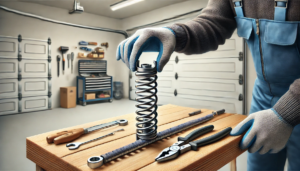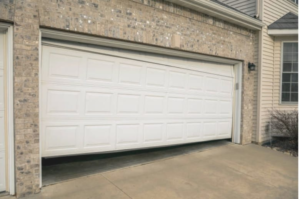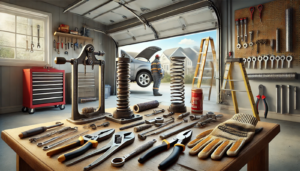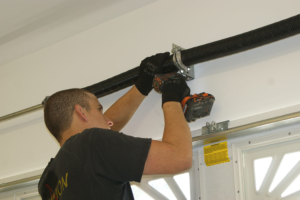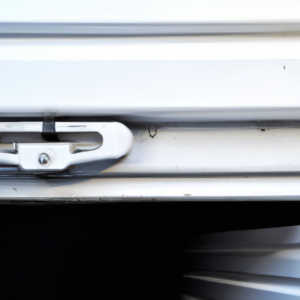Is your Roseville, CA, garage door making strange noises? It might be time for a spring replacement. Discover the signs and schedule an inspection today.
Many homeowners face garage door spring replacement, often at the most inconvenient times. One moment, their garage door works smoothly, and the next, it won’t budge. This problem is usually due to a broken spring, which plays a crucial role in balancing the door’s weight. Without a functioning spring, not only is the door inoperable, but it can also become a safety hazard.
This blog covers everything you need to know about replacing garage door springs, from recognizing the early signs of trouble to safely handling the job. Whether you’re wondering if it’s a DIY task or if you should call a professional, this guide clearly explains it all.
Keep reading to learn how to identify worn-out springs, what tools are required for replacement, and maintenance tips to prolong their lifespan. You’ll walk away feeling informed and ready to handle whatever comes next!
Recognizing the Signs: How to Know if Your Garage Door Springs Need Replacement
Garage door springs endure substantial wear and tear over time, and they eventually need to be replaced. On average, most springs last around 10,000 cycles (one cycle equals one opening and closing), which equates to approximately 5-7 years under normal use. Recognizing the signs of a worn-out or broken spring is the first step in ensuring your garage door operates safely and efficiently.
1. The Door Struggles to Open or Remains Closed
A primary function of garage door springs is to counterbalance the door’s weight, allowing it to open and close effortlessly. If you notice that your door has become difficult to lift or is stuck, it could be a sign that the springs no longer provide adequate support. Additionally, you might find the door stuck midway or moving inconsistently, which can indicate spring tension issues.
2. The Door Slams Shut
When the springs lose tension or break, the door can close rapidly, posing a safety risk. The springs may fail if your garage door shuts faster than usual or doesn’t stay up when opened. This can be particularly hazardous for pets, children, or anyone near the door.
3. Visible Gaps or Stretching in the Springs
For torsion springs, a visible gap often indicates a broken spring. On the other hand, extension springs may show signs of stretching or deformity, signaling that they are worn and need replacement. Regular visual checks for these symptoms can help catch potential spring failures before they become problematic.
4. Excessive Noise During Operation
A noticeable increase in noise, especially creaking or popping sounds, can indicate that your garage door springs are strained. In such cases, the springs may be nearing the end of their lifespan or have become misaligned. If left unchecked, noisy springs can eventually break, so it’s best to address these sounds promptly.
Understanding the Different Types of Garage Door Springs
Garage doors utilize two main types of springs, each with unique characteristics and installation requirements. Understanding these differences is essential when choosing the right replacement spring.
Torsion Springs
Torsion springs are mounted above the garage door, running parallel to it on a metal shaft. These springs work by twisting, which generates tension that aids in lifting the door. Known for their durability, torsion springs are generally safer and more stable, making them a popular choice for modern garage doors.
- Advantages: Longer lifespan, smooth and quiet operation, and better balance.
- Considerations: They require specialized installation tools and knowledge, often necessitating professional assistance.
Torsion springs are rated based on their cycle life, usually between 10,000 and 20,000 cycles, but higher cycle options are available for heavy-duty use. This type of spring can also be customized to suit various door sizes and weights, which is why they’re common in both residential and commercial doors.
Extension Springs
Extension springs are installed on both sides of the door and stretch along horizontal tracks. They extend and contract to counterbalance the door’s weight. Extension springs are typically more affordable than torsion springs and are commonly found in older garage door models.
- Advantages: Lower cost and simple installation.
- Considerations: These springs can become dangerous when they snap, making safety cables essential during installation and maintenance.
Because extension springs tend to be more affordable, they’re a suitable option for lighter doors, such as single-car garage doors. However, they lack torsion springs’ stability and smooth performance, so they are slowly being replaced by torsion systems in new installations.
The Essential Tools and Safety Precautions for Replacing Garage Door Springs
Replacing garage door springs requires meticulous care and the right tools. Safety should always be the top priority, as springs are under high tension and can cause injury if mishandled.
Tools Required
- Winding Bars (for torsion springs): Used to safely apply tension to the springs.
- Vice Grips: Useful for securing the door during the replacement process.
- Adjustable Wrenches and Sockets: Necessary for loosening nuts and bolts.
- Safety Goggles and Gloves: Protect against potential injuries.
- Ladder: A stable ladder provides safe access to the springs.
Additional equipment may include ratchet wrenches, pliers, and measuring tape for exact component alignment, especially if you’re replacing torsion springs.
Safety Precautions
- Disconnect the Garage Door Opener: Always disconnect the power to avoid accidental activation during the replacement.
- Secure the Door: Use vice grips to lock the door in an open or closed position, depending on where the spring is located.
- Handle Springs Carefully: Wear gloves and handle the springs carefully, as they are under tension.
- Avoid Over-Tightening: When installing new springs, avoid over-winding, which can damage the door and the springs.
Professional Help vs. DIY
While replacing extension springs may be manageable for a seasoned DIY enthusiast, torsion springs are best left to professionals due to the high level of skill and specific tools required. Attempting to replace torsion springs without proper experience can be hazardous. Hiring a qualified technician also ensures that the springs are installed to exact specifications, which can improve both safety and spring lifespan.
Step-by-Step Guide to Replacing Your Garage Door Springs
For those comfortable with DIY, replacing garage door springs can be accomplished with careful adherence to safety protocols. Here is a step-by-step guide for both torsion and extension spring replacements.
Replacing Torsion Springs
- Measure and Select the Correct Spring: Match your new spring to the specifications of the old one in terms of length, wire size, and wind type. Correct sizing is crucial to ensure the door operates smoothly.
- Disconnect the Door and Secure it in Place: Disconnect the opener and lock the door to prevent it from moving. Use vice grips to secure the track and prevent any unintended door movement.
- Loosen the Unbroken Spring: First, loosen and carefully unwind the intact spring using winding bars. This step releases the stored tension and prepares the shaft for the new spring.
- Remove the Damaged Spring: Once the unbroken spring is safely removed, remove the broken one by loosening the bolts that secure it to the shaft.
- Install the New Spring: Slide the new spring onto the shaft and fasten it. Wind it carefully according to the required number of turns. Each type of door has specific winding requirements, so follow the manufacturer’s recommendations.
- Test the Door: Remove the vice grips and reconnect the opener. Test the door to ensure it opens and closes smoothly.
Replacing Extension Springs
- Detach the Old Spring: Unhook the extension spring from the brackets and the pulley system. Be mindful of the tension in the spring, as it can snap back.
- Install Safety Cables: If your old extension springs didn’t have safety cables, now is an excellent time to install them. Thread the cable through the spring and secure it to the bracket. Safety cables are crucial in preventing injury if the spring were to break.
- Attach the New Spring: Connect the new spring to the pulley system and the bracket. Double-check the connections to ensure stability.
- Reconnect and Test the Door: Reconnect the opener and check the door’s balance and movement. The door should open smoothly without resistance or slamming shut.
Maintenance Tips for Prolonging the Life of Your Garage Door Springs
Regular maintenance can extend the life of your garage door springs, helping you avoid the hassle and cost of frequent replacements. Here are some tips to keep your springs in top condition:
1. Lubricate the Springs Periodically
Apply a light coating to the springs every six months using a silicone-based spray or a dedicated garage door lubricant. Lubrication reduces friction and wear, prolonging the lifespan of the springs.
2. Perform Regular Balance Tests
To test the balance, disconnect the opener and lift the door manually. If the door stays in place, it’s balanced. The springs may need adjustment or replacement if it slams shut or feels too heavy. Regular balance checks can identify small issues before they turn into significant problems.
3. Inspect the Springs for Signs of Wear
Check for any visible gaps, rust, or stretching in the springs. Catching these signs early can prevent unexpected breaks and ensure your door operates safely. If you notice rust, consider treating it with a rust-inhibiting spray, but avoid painting the springs, as this can hinder their flexibility.
4. Avoid Overuse
Limiting the number of daily cycles can significantly extend the life of your garage door springs. Consider alternative access points if you frequently open and close the garage door. Using a pedestrian door, if available, can minimize wear on the springs and other components of the garage door system.
Common Questions about Garage Door Spring Replacement
Are all garage door springs the same?
No, not all garage door springs are the same. They vary in type, length, wire size, and diameter. Torsion and extension springs are the two main types, each designed for different door systems. Additionally, the spring specifications depend on the garage door’s weight and dimensions.
What is the lifespan of a garage door spring?
The lifespan of a garage door spring is usually measured in cycles, with one cycle being one complete opening and closing of the door. Most standard springs last between 10,000 to 15,000 cycles, which equates to about 7 to 12 years of regular use. High-cycle springs can last longer but come at a higher cost.
Why do garage door springs break?
Garage door springs break primarily due to wear and tear over time. The springs undergo stress each time the door opens and closes, eventually leading to metal fatigue. Other causes include lack of maintenance, rust build-up, or extreme temperature fluctuations, all of which can weaken the springs over time.
Should you replace both garage door springs at the same time?
Yes, replacing both garage door springs at the same time is recommended if your door uses two springs. Even if only one spring breaks, the other is likely worn out as well. Replacing them together ensures balanced door operation and can save you from needing another repair in the near future.
Does a garage door need 2 springs?
Not all garage doors need two springs. Single-car garage and lighter doors may only need one spring, typically a torsion spring. However, larger and heavier garage doors often require two springs to distribute the weight evenly, enhancing balance and prolonging the lifespan of the door system.
Conclusion
Replacing garage door springs is a significant task that demands a solid understanding of the type of spring in use, the right tools, and a commitment to safety. Whether you undertake the project yourself or seek professional assistance, maintaining your springs and recognizing the early signs of wear can save you time, money, and potential injury. With routine checks and proper maintenance, you can ensure your garage door operates smoothly for years ahead.
End Note
At Perfect Solutions Garage Door Inc., we know that a broken garage door spring can cause significant inconvenience, leaving your door inoperable and your garage unusable. That’s why we specialize in professional garage door spring replacement, ensuring your door is back in working order quickly and safely. We partner with top brands like Amarr, Wayne Dalton, CHI, and Clopay, providing you with the highest-quality products available on the market.
We also trust Liftmaster for garage door openers, offering smooth and reliable operation for years. Whether you need a spring replacement or a full garage door overhaul, our experienced team is ready to help. Explore our gallery and check out some of our recent projects. Learn more about all our services here, or reach out for emergency repairs. For tips and updates, don’t forget to visit our blog.

